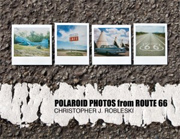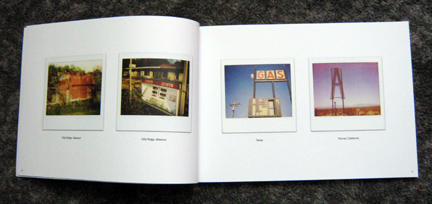Polaroid photography was immensely popular decades ago, but corporation that made it eventually stopped its production as its use faded. But a small but enthusiastic group continues to keep the original Polaroid format alive because of its unique look and unpredictable qualities.
 If that description seems to match the boom, bust, and small revival of Route 66, you’re not the only one to have noticed. Christopher Robleski saw it as well, and those parallels prove inescapable in his new photography book, “Polaroid Photos from Route 66” (160 pages, soft cover, Living Beyond Reality Press, $34.99).
If that description seems to match the boom, bust, and small revival of Route 66, you’re not the only one to have noticed. Christopher Robleski saw it as well, and those parallels prove inescapable in his new photography book, “Polaroid Photos from Route 66” (160 pages, soft cover, Living Beyond Reality Press, $34.99).
Over the years, Robleski has used more than a dozen Polaroid cameras on the Mother Road to capture hundreds of images. He concentrates on Route 66’s neon signs, many which have become “battered bones and shells of their former glory, bleached by decades of sun, rusted by decades of rain.”
Polaroid film — especially packets that are decades old — sometimes develops unevenly. Shots sometimes provide highly saturated color. Some images come with yellowed or greenish tints. And with the peel-apart instant Fuji film that Robleski occasionally uses, the ragged black glue remains on the edges of the image.

It is the unpredictable nature of instant film that adds intrigue. The partially faded black-and-white image of the Central Camera neon sign in Chicago — especially with its “since 1899” message — looks like something shot during the Great Depression. And a fuzzy color image of a fast-decaying Zephyr gasoline billboard near Villa Ridge, Mo., adds poignancy.
Among the most striking images are a side-by-side of the neon signs of the Rest Haven Motel in Afton, Okla., and the Rest Haven Court in Springfield, Mo. The former has faded to the point when the “Motel” part is barely legible, and the image’s color seems almost as decayed … washed out to almost a beige. The vintage Rest Haven Court sign, however, appears bright and vibrant, as if the decades have not affected it one iota.
The book may be trip back in time for some readers. In fact, Robleski says a number of the neon signs shown in the book have been “destroyed by weather, by the earth, or by human hands” since he began his Route 66 travels.
One pleasant surprise is Robleski’s writing. Among the essays he sprinkles into the book are musings about the Rock Cafe, Lou Mitchell’s, Blue Swallow Motel, Motel Safari, Whiting Bros. stations, Blue Whale, Munger Moss Motel, and the ghost towns of Texola and Glenrio.
Here’s an excerpt about his experience at one unnamed Route 66 motel:
I picked a homely old motel, no bells-and-whistles. Judging by the motley crew gathered outside their rooms in the front lot, I was going to spend the night in a place clearly rented out to permanent residents. Despite my atypical choice of digs on the road, it wasn’t long before I started to chat with these locals. I listened to them share amazing stories of their constant survival. True, some of their rough paths were self-inflicted. But that wasn’t what I took away from our conversations, as their stories were full of fervent hope. After a few more tall tales and cold beers, I returned to my room for some much needed shut-eye. The following morning, I shook a few hands and moved onto the next town.
There’s no telling how long Robleski’s beloved Polaroid film will remain available. However, the format has been reborn in unexpected ways. Polaroid has been revived in the digital age, with new instant cameras and adaptations for smartphones.
And people who use Instagram, one of the most popular and highly rated Apple iPhone apps, have discovered the joy of unpredictable and intriguing image filters.
Perhaps the old-school film of Polaroid will eventually disappear. But, like Route 66, it likely will live on in an intriguing new way in the 21st century.
(“Polaroid Photos from Route 66” can be purchased from Robleski’s FadingNostalgia.com site.)
I’ve been corresponding with Chris ever since I got his postcard, and his book is on the way to my door. What intrigues me and impresses me is that in a world where just about every angle has been worked to pique interest in Mother Road imagery, he has found a long-dormant nostalgic nerve to touch. How could any self-respecting road warrior resist?
Ron, thank you so much for such a stellar review! You captured everything about the book so eloquently. It’s also really cool to see what specific parts you respond to most! Jim, I want to thank you too for your support! I hope fans of 66, as well as fans of general Americana are able to transport back to times when Polaroid was *the way to capture their memories, via this book.